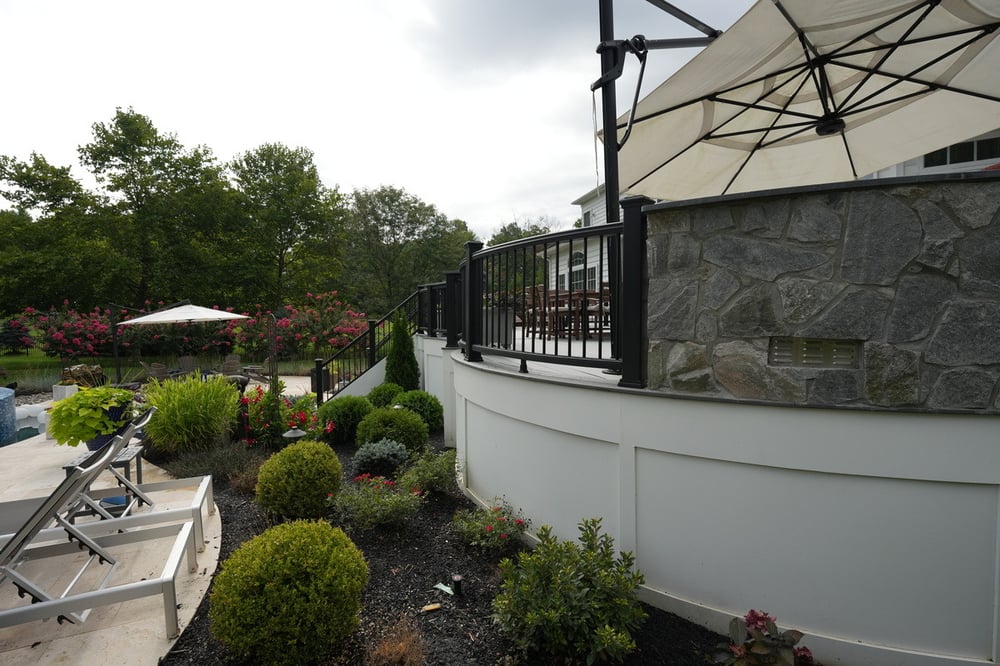4 Min Read
The Importance of Drainage in Your Outdoor Space
You’ve put time and effort into designing your perfect outdoor space—choosing the right materials, creating inviting seating areas, and adding thoughtful landscaping. But if water doesn’t drain properly, your dream space can quickly turn into a maintenance nightmare. The secret to a long-lasting, low-maintenance backyard? A drainage plan that works with your landscape, not against it.
At Deckscapes of Virginia, we specialize in designing and building custom decks, patios, and outdoor living spaces. Serving Fairfax, Loudoun, and Prince William Counties, our expert team ensures that every project includes proper drainage solutions to protect your investment and enhance your outdoor experience. With years of experience in high-end outdoor construction, we understand how to manage water flow, prevent damage, and create spaces that stand the test of time.

Site Analysis & Planning for Proper Drainage
A drainage and grading assessment is essential before any outdoor construction begins to prevent costly water-related issues.
Identifying Water Flow Patterns
Understanding how water moves across the property is the first step in proper drainage planning. Low-lying areas where water pools can cause long-term issues, so recognizing these problem spots early is essential. Common signs of poor drainage include:
- Puddles or soggy areas that remain long after rain.
- Erosion patterns in soil or mulch.
- Water stains on patios or deck footings.
Testing & Improving Soil Drainage
Different soil types absorb water at different rates. A soil drainage test can help determine if adjustments are needed. Solutions may include:
- Adjusting grading to create a slight slope for better runoff.
- Installing drainage swales or French drains to divert water.
- Using soil amendments to improve water absorption in compacted areas.
Preventing Long-Term Drainage Issues
Addressing drainage concerns before construction can help homeowners avoid costly repairs and structural problems. Key strategies include ensuring that all hardscapes and landscaped areas are properly sloped and that runoff is directed away from foundations and outdoor structures.
Integrated Drainage for Decks & Patios
Proper drainage planning is especially important for decks and patios, as standing water can lead to material deterioration, mold growth, and unstable foundations.
Deck Drainage Considerations
A well-built deck must have a slight slope, typically about 1/8 inch per foot, to encourage runoff. Knowing how to slope a deck for water runoff and drainage ensures water doesn’t accumulate on the surface, reducing slip hazards and material degradation. Deck footings should be positioned to avoid water collection, as excess moisture can weaken structural components over time.
Strategic placement of downspouts and drains is also crucial. When gutters and downspouts release water too close to a deck’s foundation, erosion can introduce instability in the surrounding soil. Properly extending downspouts away from the deck or connecting them to underground drainage solutions can prevent these issues.

Patio Drainage Solutions
Like decks, patios should also be designed with a slight slope to guide water away from the house and prevent pooling. Patio drainage solutions may include the following.
- Permeable pavers that allow water to drain through the surface, reducing runoff.
- Channel drains installed between patio sections to collect and redirect water.
- Gravel or crushed stone bases that promote natural water absorption.
.jpg?width=1000&height=667&name=DSC00005%20(1).jpg)
Under-Deck Drainage Systems
An under-deck drainage system is essential for maximizing the use and lifespan of a deck. Without one, rainwater can drip through the boards, leaving the area below damp and unusable while also exposing the deck’s framing to moisture damage.
Benefits of an Under-Deck Drainage System
Installing an under-deck drainage system keeps the space below dry, making it perfect for storage, seating, or even an outdoor kitchen. It also protects the deck’s structure by preventing moisture buildup that can lead to wood rot and deterioration.
Choosing the Best Under-Deck Drainage System
You have several options for creating drainage for your deck in Northern Virginia. The best time to create under-deck drainage is during construction.
- Over-joist systems (such as the Trex deck drainage system) that capture water before it reaches the frame.
- Under-joist systems that attach below the deck and channel water away.
- Custom solutions like sloped ceilings or integrated gutter systems for high-end projects.
.jpg?width=1000&height=750&name=IMG_4986%20enhanced%20(2).jpg)
Permeable Hardscapes & Materials for Drainage
Hardscape materials play a crucial role in managing outdoor drainage. Traditional solid surfaces can contribute to runoff and pooling, but permeable hardscapes allow water to drain naturally.
What Are Permeable Pavers?
Unlike standard concrete or stone, permeable pavers are designed to let water pass through small gaps, allowing it to filter into the ground. This prevents standing water and runoff and reduces stress on local drainage systems, supporting eco-friendly water management by replenishing groundwater.
Permeable materials are a common outdoor living upgrade, working alongside features like patios, pools, and outdoor kitchens to create a functional and visually cohesive backyard.
Types of Permeable Hardscapes
Homeowners have several options when designing a permeable deck or patio.
- Permeable pavers – Interlocking stones with built-in drainage gaps.
- Gravel pathways – A natural, cost-effective way to absorb water.
- Porous concrete & permeable asphalt – Specialty materials that allow water infiltration while maintaining a solid surface.
Landscaping Strategies for Water Management
Thoughtful landscaping plays a major role in controlling excess water and preventing drainage issues.

Using Landscaping to Improve Drainage
Certain landscaping techniques help manage runoff and prevent erosion.
- Drainage swales – Shallow, sloped channels that direct water away from foundations.
- French drains – Gravel-filled trenches with perforated pipes that collect and redirect water.
- Dry creek beds – Decorative rock-lined channels that guide excess water while enhancing aesthetics.
Choosing the Right Plants for Water Management
Some plants absorb excess moisture and help stabilize the soil. Consider strategically planting the following with drainage in mind.
- Deep-rooted native plants to prevent erosion.
- Moisture-absorbing ground cover like ferns or creeping thyme.
- Rain gardens with water-loving plants to naturally filter runoff.
Mulch is another effective tool, helping retain moisture in dry areas while preventing soil displacement in areas prone to excess water.

Additional Considerations for a Complete Drainage Plan
A well-designed drainage system protects your home and ensures that excess water is managed responsibly. Beyond decks, patios, and landscaping, other elements can play a key role in preventing water-related damage.
Rainwater Harvesting
Instead of letting water go to waste, rainwater harvesting systems collect runoff from roofs and store it for irrigation. This reduces reliance on municipal water sources while helping manage excess water.
Gutter & Downspout Considerations
Gutters and downspouts are essential for directing water away from a home’s foundation. To improve their effectiveness:
- Ensure downspouts extend far enough from the house.
- Use splash blocks or underground drainage pipes to prevent pooling.
- Regularly clean gutters to avoid overflow and leaks.
Preventing Runoff Issues for Neighboring Properties
Poor drainage planning can lead to runoff affecting neighboring yards. Follow these steps to avoid disputes or unintended damage.
- Make sure grading directs water toward proper drainage areas.
- Avoid diverting water onto neighboring properties.
- Consult local regulations to ensure compliance with runoff management laws.
Protect Your Outdoor Space with Comprehensive Backyard Solutions in Northern Virginia
Serving homeowners across Fairfax, Loudoun, and Prince William Counties, Deckscapes of Virginia designs and builds high-end outdoor spaces with every detail, including drainage, in mind. Contact Deckscapes of Virginia today to schedule a consultation and plan a functional, long-lasting outdoor living space.




